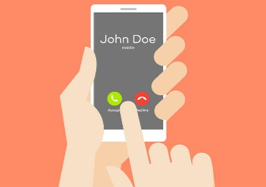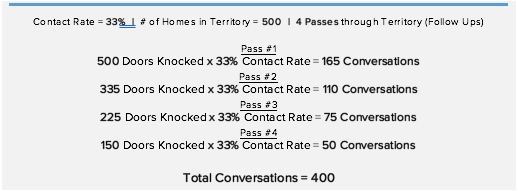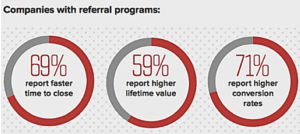One of the greatest challenges facing any sales team is getting sales reps to follow-up with potential customers. Sales reps despise trying to get in touch with people that don’t answer as often as they like no matter how good the lead is.
Follow-ups, whether it’s a call, email or visit, are one of the most frustrating things for salespeople to do. They want to close the deal now and seem to dismiss a prospect who doesn’t buy from them on their timeline. It’s like there’s a negative association among prospects who don’t make a purchasing decision on the sales rep’s timeline.
Key to Remember: Timing is everything and people buy when they’re ready to buy, not when you’re ready to sell.
Intriguing Follow-Up Stats
By now, you’ve surely seen some type of data related to the number of follow-up activities required in order to set an appointment or close a deal. Maybe it came from a coworker trying to sound smart or you read about it because “Johnny Know-It-All” tweeted it and clogged up your feed.

This data is definitely factual, especially in today’s fast paced, and social media frenzied society. Everyone appears to be glued to their smartphones, yet no one seems to be able to hit that little green button to take a call when their phone rings.
Here’s what you need to know about how few salespeople follow-up and what it actually requires to get in touch with a potential customer after an initial conversation:
- 48% of salespeople never even make a single follow-up attempt
- 44% of sales reps give up after just one follow-up attempt
- The average salesperson only makes 2 attempts to even reach a prospect
- 80% of sales require at least 5 follow up attempts after the initial meeting
- If you follow up with a prospect within 5 minutes of their outreach to you, you’re 9x more likely to convert them
[Source: HubSpot]
Why Sales Follow-Up Is So Dismal
There’s plenty of blame to go around for the lack of follow-up attempts that sales reps make. It doesn’t matter if you’re an SDR on an inside sales team or a sales rep going door to door.
The blame lies in 3 areas of a sales organization:
- Upper-level management: VP’s / Directors of Sales / C-levels
- Sales managers: Who sales reps report to
- Sales reps and canvassers It’s a trickle-down effect that has led statistics like these to plague the industry. Part of the job is following-up, it’s that simple. Yet, if “persistence” is in almost every job description, why isn’t it being done?
![]()
We’ve already mentioned how sales reps and canvassers despise having to follow-up with prospects, but it’s likely due to a lack of proper training and not being held accountable. When it takes an average of 18 calls to connect with a buyer, there’s no shot in hell that one or two will suffice.
Sales managers should know the value each lead represents to the company in terms of revenue. They should create an implement a follow-up process based on actual data for sales reps and canvassers. If it’s implemented it has to be enforced, and their team has to be held responsible.
Anyone in a C-level position not looking at activities is significantly affecting their revenue and profit margins. They have the ultimate responsibility to recognize their cost per lead is rising as a result of how many need to be generated because they’re not being worked thoroughly.
They should also spot a trend in the amount of commission being paid out. It’s increasing because they’re having to pay for more leads that aren’t converting.
The Effects of Not Following-Up
You’ll only talk to about 33% of the people you visit on your first pass through a neighborhood, and you should be working that neighborhood to a 75% contact rate.
Here’s an example assuming the following:

Congrats!
Out of 500 potential customers, you only generated 6 sales and it’s not going to change. The territory encompassing these 500 houses belongs to a sales rep who’s one of the 48% of salespeople who never make a single follow up attempt.
Because this person will never be back:
- 27 leads will never hear from your company again
- 133 prospects won’t get more information about your company
- 335 potential customers who didn’t answer will never even hear about your company
- You paid commission for 27 leads that will never convert
Now – Watch what happens if the same sales rep works the neighborhood to a 75% market penetration rate using a follow up cadence. (If you’re not familiar with this, you can click the orange text to learn more about why you should make a minimum of 4 attempts in each neighborhood and how your market penetration rate and how it’s calculated)

By following-up and revisiting the houses that didn’t answer each time, 400 prospects have now heard about your company. You’ve put your company in the face of over 80% of the homeowners in this territory.
Forget about how many sales converted on the spot, this person now has an entire pipeline full of potential customers to work and you’re not leaving revenue on the table. You’ll at least be able to get an answer from a lot of these people and know that you had the opportunity to pitch them instead of wondering if any of them were interested.

There’s no doubt you’ll generate revenue if you speak with 400 consumers. It’s much easier to get a new customer in an area where you have existing customers. Neighbors talk and 9 out of 10 buying decisions are made with peer recommendations. Your company’s presence and reputation in that neighborhood will spread and lead to additional sales.
It will also lead to referrals, which are your highest converting and cheapest leads. This is significant because 92% of buyers trust referrals from people they know and 83% of customers are willing to provide a referral after a positive experience.
The importance of follow-ups extend well beyond just working a lead to get that one deal.
The Do’s of Follow-Ups
High performing sales organizations are twice as likely to provide ongoing training as low performing organizations. Because of how difficult it is to reconnect with a prospect after a presentation, it’s vital for sales reps to be trained on how to handle the conversation.
Determine the Best Method
Prior to the end of the conversation or presentation, ask the prospect what the best method to follow-up with them is. This is often overlooked and assumed. No one will know better than the customer themselves, and you don’t know if you don’t ask.
You want to know if there’s any specific information they’d be interested in and the times that typically work best for them. The method used to follow up is referencing the information that needs to be sent or shared.
Determine the Preferred Method of Contact
Along the same lines, you want to know how they like to communicate. Some people like emails more than calls, but some would prefer a text over an email. One of the most important reasons to determine how they like to communicate is to avoid being annoying. Nothing will turn a prospect away quicker.
With only 3% of buyers saying they trust salespeople (the lowest of any profession behind only car sales, politics and lobbyists), it’s essential to be viewed as a credible professional. Blowing their phone up and annoying them will only destroy the hard work you’ve put in.
Always Have a Specific Reason to Contact the Prospect
When the follow up isn’t 100% focused on the sales rep, response rates and engagements increase. It’s fine to follow up to ask for the sale, but have a reason for doing that. Track your potential customers and stay connected with them, even if you’re not actually communicating.
When it’s time to revisit them or give them a call, you’ll have something other than just business to talk about. This will help you build rapport and establish credibility. When it’s finally time to get into the nitty gritty, there will be a much lighter and friendlier mood.
Always Provide Value
One of the most important things for salespeople to do is be value focused. It goes beyond customer service. Anything that happens throughout the sales process should force the sales rep to think about how they can add value to the customer’s life, and how their service solves a problem.
Value can be anything from additional resources you thought they might like to offering a discount. Keep in mind that value doesn’t always correlate to money; you don’t have to give your service away.
End Each Conversation with a Clearly Defined Next Step
The easiest time to get a commitment for the next step is at the end of the conversation you just had. It’s almost a certainty the prospect has their schedule in front of them on their smartphone. Nothing will leave you more frustrated than trying to get back in touch with someone you thought was a quality lead.
Capitalize on this moment and lock them down to a next step by asking for it. So many sales reps shoot themselves in the foot by not being firm on this. You can’t let the prospect tell you, “Come back next week sometime in the afternoon.” Once they leave without committing to anything on their end it becomes a game of cat and mouse trying to re-engage.
One Major Thing to Avoid When Following Up on Sales Leads
NEVER JUST FOLLOW UP TO “CHECK IN” OR “TOUCH BASE”
This awful, terrible phrases mean that you have absolutely no reason to speak with them. No reason to speak with them means that they don’t have a reason to speak with you and you’re wasting their time.
If they needed to check in with you, they would have contacted you one way or another. What is there to check in on? It’s lazy and unprepared. You’re not adding anything to their life or helping them solve a problem, you’re just adding to the number of people they already don’t want to speak with.
______
SPOTIO is the #1 field sales engagement and performance management software that will increase revenue, maximize profitability, and boost sales productivity.
Want to see a product demonstration? Click here to see how SPOTIO can take your sales game to the next level.


